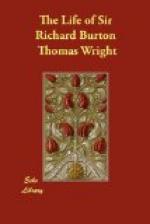[FN#564] Lib. Ed., x., p. 342. xi., p. 1.
[FN#565] Lib. Ed., xii.
[FN#566] Burton differed from Mr. Payne on this point. He thought highly of these tales. See Chapter xxxv, 167.
[FN#567] This paragraph does not appear in the original. It was made up by Burton.
[FN#568] One friend of Burton’s to whom I mentioned this matter said to me, “I was always under the impression that Burton had studied literary Arabic, but that he had forgotten it.”
[FN#569] Life, ii., 410. See also Romance, ii., 723.
[FN#570] As most of its towns are white, Tunis is called The Burnous of the Prophet, in allusion to the fact that Mohammed always wore a spotlessly white burnous.
[FN#571] As suggested by M. Hartwig Derenbourg, Membre de l’Institut.
[FN#572] The nominal author of the collection of Old English Tales of the same name.
[FN#573] Ridiculous as this medical learning reads to-day, it is not more ridiculous than that of the English physicians two centuries later.
[FN#574] Juvenal, Satire xi.
[FN#575] Religio Medici, part ii., section 9.
[FN#576] We should word it “Pauline Christianity.”
[FN#577] Arabian Nights, Lib. Ed., vii., 161.
[FN#578] See the example we give in 160 about Moseilema and the bald head.
[FN#579] Also called The Torch of Pebble Strown River Beds, a title explained by the fact that in order to traverse with safety the dried Tunisian river beds, which abound in sharp stones, it is advisable, in the evening time, to carry a torch.
[FN#580] Mohammed, of course.
[FN#581] It contained 283 pages of text, 15 pages d’avis au lecteur, 2 portraits, 13 hors testes on blue paper, 43 erotic illustrations in the text, and at the end of the book about ten pages of errata with an index and a few blank leaves.
[FN#582] He also refers to it in his Arabian Nights, Lib. Ed., vol. viii., p. 121, footnote.
[FN#583] See Chapter xxvi.
[FN#584] But, of course, the book was not intended for the average Englishman, and every precaution was taken, and is still taken, to prevent him from getting it.
[FN#585] Court fool of Haroun al Rashid. Several anecdotes of Bahloul are to be found in Jami’s Beharistan.
[FN#586] A tale that has points in common with the lynching stories from the United States. In the Kama Shastra edition the negro is called “Dorerame.”
[FN#587] Chapter ii. Irving spells the name Moseilma.
[FN#588] Chapter ii. Sleath’s Edition, vol. vi., 348.
[FN#589] It must be remembered that the story of Moseilema and Sedjah has been handed down to us by Moseilema’s enemies.
[FN#590] The struggle between his followers and those of Mohammed was a fight to the death. Mecca and Yamama were the Rome and Carthage of the day—the mastery of the religious as well as of the political world being the prize.




